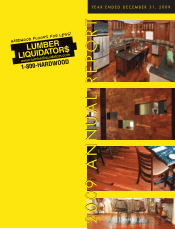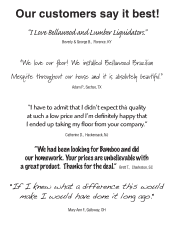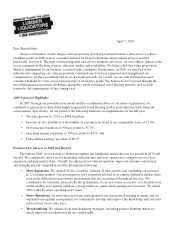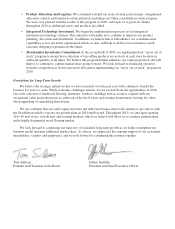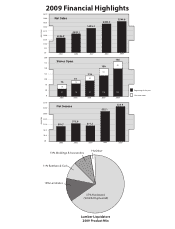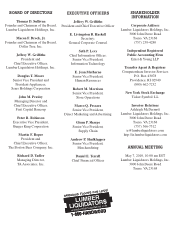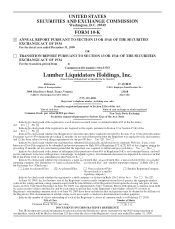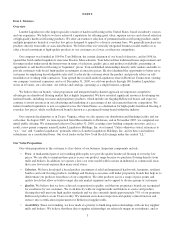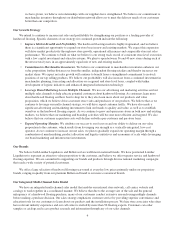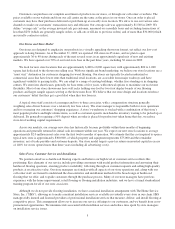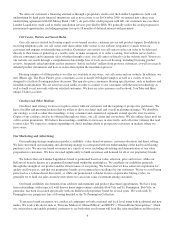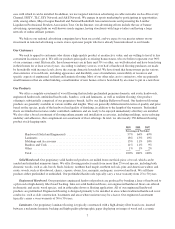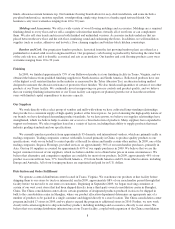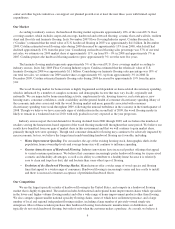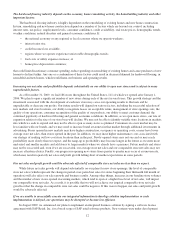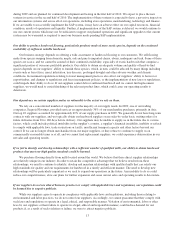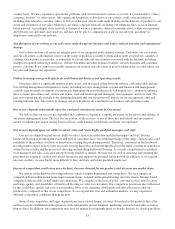Lumber Liquidators 2009 Annual Report Download - page 11
Download and view the complete annual report
Please find page 11 of the 2009 Lumber Liquidators annual report below. You can navigate through the pages in the report by either clicking on the pages listed below, or by using the keyword search tool below to find specific information within the annual report.Customers can purchase our complete assortment of products in our stores, or through our call center or website. The
prices available on our website and from our call center are the same as the prices in our stores. Once an order is placed,
customers may have their purchases delivered or pick them up at a nearby store location. We strive to use our various sales
channels to make our customers’ transactions easy and efficient. Our average sale was approximately $1,560 in 2009. We
define “average sale” as the average invoiced sale per customer, measured on a monthly basis and excluding transactions of
less than $250 (which are generally sample orders, or add-ons or fill-ins to previous orders) and of more than $30,000 (which
are usually contractor orders).
Our Stores and Store Model
Our stores are designed to emphasize our products in a visually appealing showroom format, yet reflect our low-cost
approach to doing business. As of December 31, 2009, we operated 186 stores in 45 states, and we plan to open
approximately 36 to 40 stores during each of the next several years in an approximately equal mix of new and existing
markets. We have opened over 50% of our total store base in the past three years, including 36 stores in 2009.
We look for new store locations that are approximately 6,400 to 6,600 square feet, with approximately 800 to 1,000
square feet dedicated to the showroom selling area. With our significant brand marketing, we believe our store locations are a
“must visit” destination for customers shopping for wood flooring. Our stores are typically located in industrial or
commercial areas that have lower rents than traditional retail locations, are accessible from major roadways and have
significant visibility to passing traffic. We can adapt to a range of existing buildings, whether free-standing or in shopping
centers. We enter into short leases, generally for base terms of five years, with renewal options to maximize our real estate
flexibility. Most of our store showrooms have wall racks holding one-foot by two-foot display boards of our flooring
products and larger sample squares serving as the showroom floor. We believe that our store design and locations reinforce
our customers’ belief that they get a good deal when they buy from us.
A typical store staff consists of a manager and two to three associates, with a compensation structure generally
weighting sales-driven bonuses over a relatively low base salary. The store manager is responsible both for store operations
and for overseeing our customers’ shopping experience. A store’s warehouse is stocked with a combination of that store’s
most popular products and high-volume items, as well as customer-specific merchandise inventory waiting to be picked up or
delivered. By generally requiring a 50% deposit when an order is placed for product not taken home that day, we reduce
store-level working capital requirements.
Across our markets, our average new store has historically become profitable within three months of beginning
operations and generally returned its initial cash investment within one year. We expect our new store locations to average
approximately $2.0 million in net sales over the first twelve months of operation. We estimate that the cost required to open a
typical new store is approximately $300,000, of which property and equipment represents $75,000 and the remainder
inventory, net of trade payables and customer deposits. Our store model targets a pre-tax return on invested capital in excess
of 140% for stores opened more than three years (including all advertising costs).
Sales Force, Customer Service and Installation
We position ourselves as hardwood flooring experts and believe our high level of customer service reflects this
positioning. Key elements of our service include providing consumers with useful product information and answering their
hardwood flooring questions, ensuring product availability, following through on customer requests and selling high-quality
products at an attractive value. Our store managers are familiar with all aspects of our store operations and, along with our
call center staff, are trained to understand the characteristics and installation method for the broad range of hardwood
flooring that we offer, and to guide customers through the purchase process. Many of our store managers have previous
experience with the home improvement, retail flooring or flooring installation industries, and we have a formal standardized
training program for all of our store associates.
Although we do not provide flooring installation, we have a national installation arrangement with The Home Service
Store, Inc. (“HSS”), allowing us to make consistent installation services available in virtually every store in our chain. HSS
manages fully insured and licensed providers of professional installation services that measure, deliver, and install flooring at
competitive prices. This arrangement allows us to increase our service offerings to our customers, and we benefit from cross-
promotional opportunities. We minimize risk associated with installation services and reduce time spent by store managers
on installation service issues.
5

